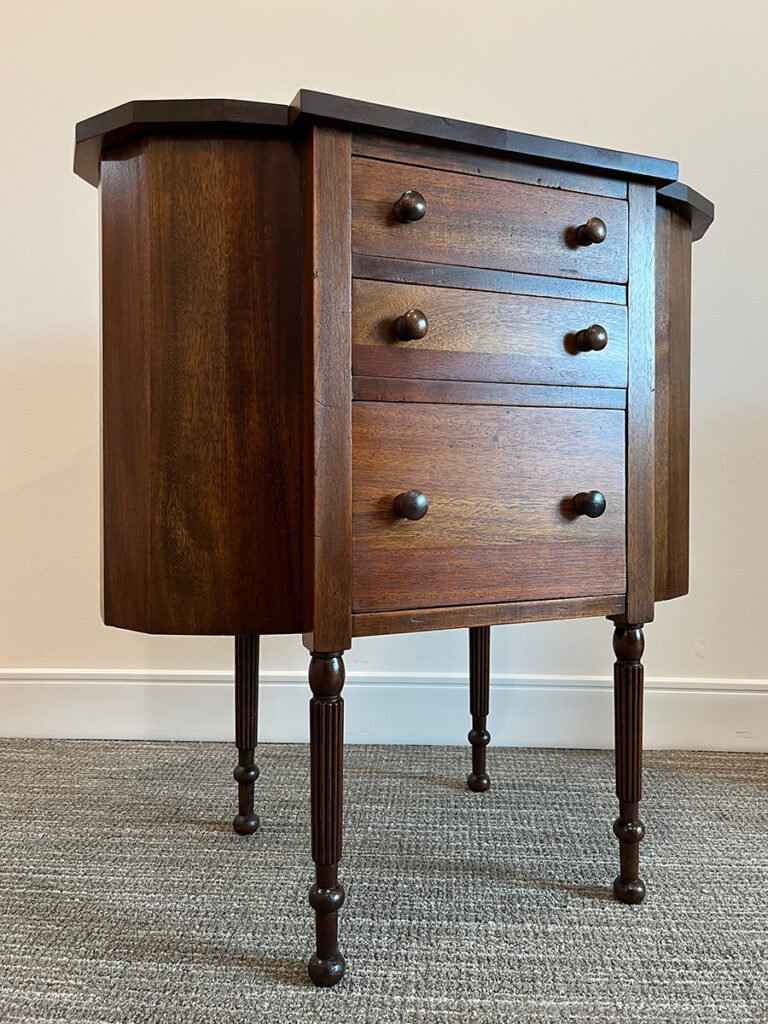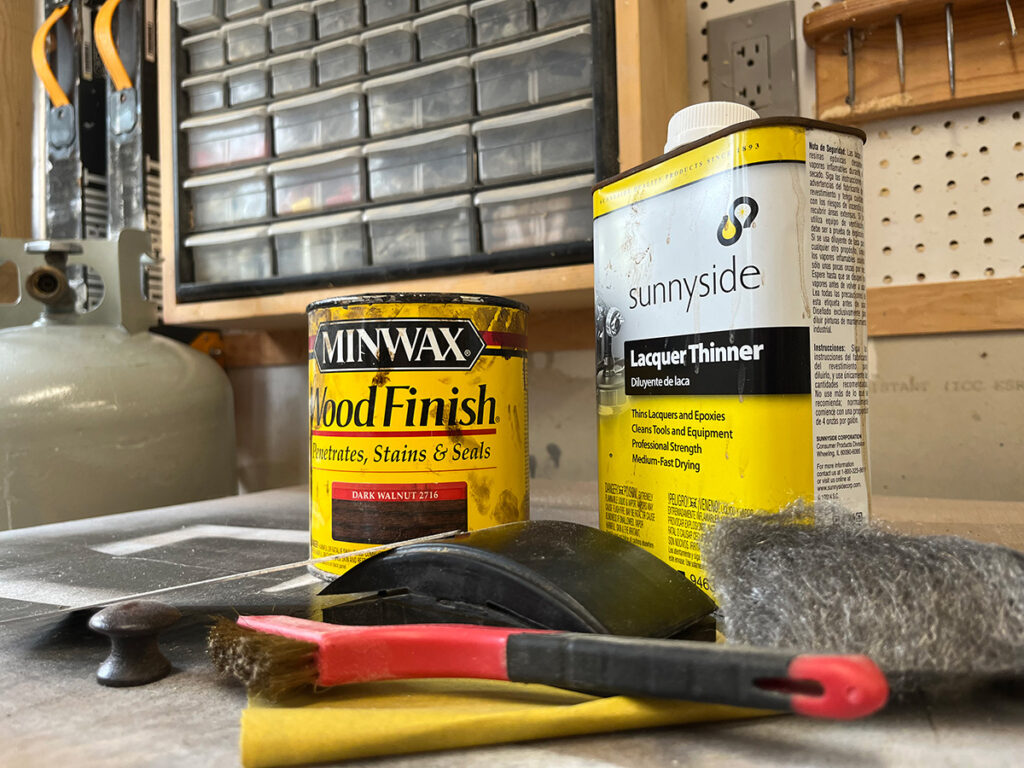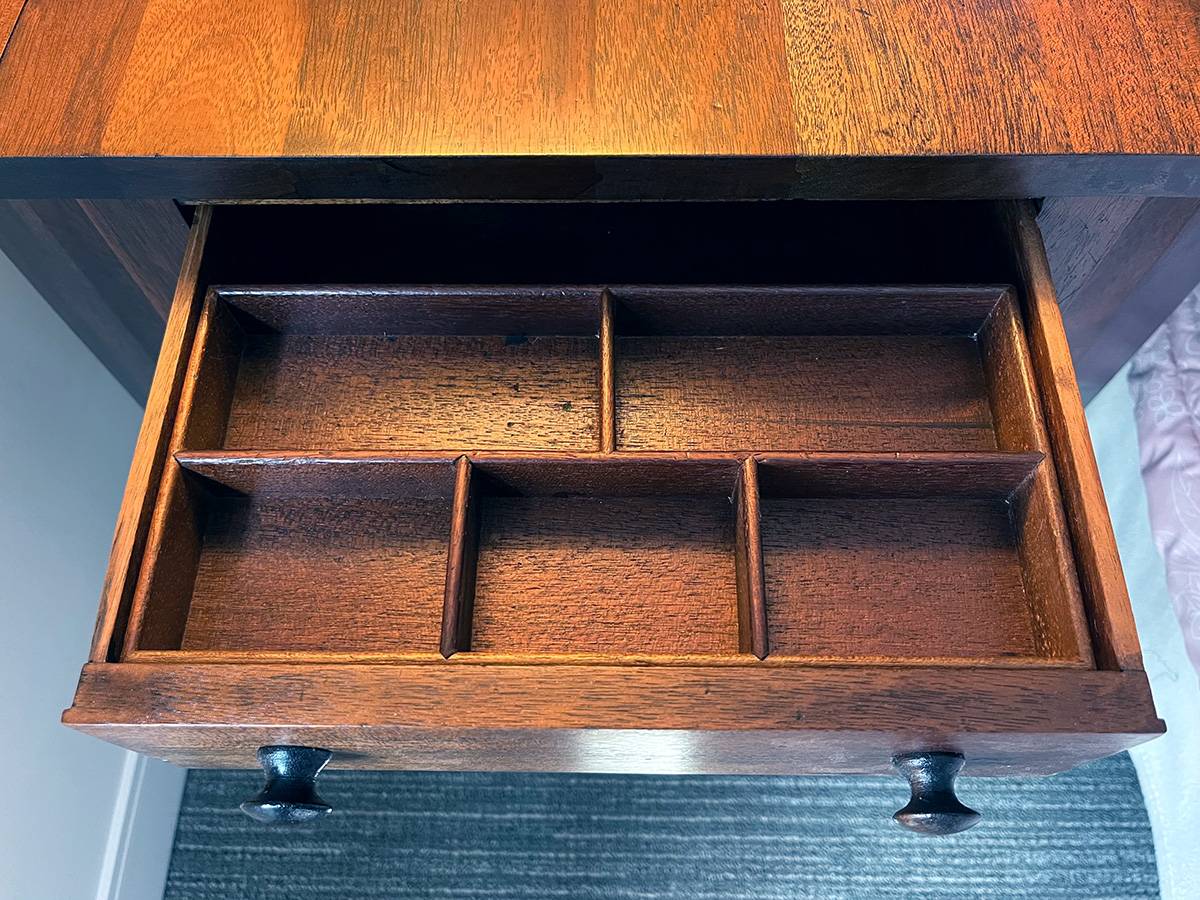A confession. I have more than a few times embarrassed a family member (mostly my daughter, Emilie) by pulling curbside to examine a forlorn piece of furniture. “I could fix that,” I say to myself. Occasionally trash does beget treasure, and I load the found thing onto my truck with moral purpose.

Two years ago, it was a Martha Washington style mahogany sewing cabinet (c. 1920s) manufactured in Chicago by W. K. Cowan and Co. The piece had a few problems: its varnish was scratched and discolored, drawer pulls were missing, and most concerning, barrel hinges connecting two sections of cabinet top had been severed. I granted the piece coveted space in my shop but with no immediate plan to restore it. Finally, last month, while sorting major decisions about my wife’s care, I started in. I brushed on a thick coat of paint stripper, let it sit for a bit, and removed the mess with a sharp-edged scraper. For deeper cleaning, lacquer thinner and 000 steel wool did a good job. Wanting to highlight the woodgrain, I applied Minwax stain with a soft rag followed by a first coat of clear spray lacquer. To finish, I scuff-sanded the entire cabinet with 400 grit paper, wiped it down with a tack cloth, applied a final coat of lacquer, and replaced the pulls and hinges.

While restoring the sewing cabinet, an older memory surfaced. On August 23, 1975, in the presence of family and friends, C.K. and I exchanged marriage vows. Eager to enter our new life together, we could not say how our future—marriage, my grad studies at Cranbrook Academy of Art, or life in Pontiac, Michigan—might go, but I was determined we would have furniture. During that last summer of living at home with my parents before the wedding, I used weekends to hunt for yard-sale bargains, furniture with good bones and a little character. And so it went, scattered about their two-car garage and in various states of promise and disrepair: a dresser, chest of drawers, and two nightstands, a dining room table with six chairs, a China cabinet, and a bookcase. After work and a quick dinner, I spent many evenings refinishing furniture. It was what I could do.
Following a short honeymoon, we loaded our things into a moving van with care and that Labor Day weekend drove from Milwaukee to Pontiac to settle into our first apartment. Twelve place settings of Bill Hill Noritake porcelain, my mother’s wedding gift to us, fit smartly in the China cabinet. No doubt Mom imagined us setting a nice table, maybe with a vase of flowers, for family and friends, and we did. We stowed lingerie, T-Shirts, jeans, and sweaters in the bedroom furniture. No money to spare, our bookshelves filled slowly. I cherish still C.K.’s gift to me, a hardbound copy of The Stories of John Cheever. I recall giving her Richard Adams’ Watership Down, also hardbound. We hung art. We were just beginning.
In 1979 we moved to Eau Claire, Wisconsin; our son, Jesse was born, we purchased and remodeled a little house on Rust Street near the university. Soon our daughter, Emilie arrived. Seven years later we moved to a roomier home, again near to campus, but in Madison, Wisconsin. Family, new friends, and countless students gathered in our home. C.K. inherited a handsome cherrywood bedroom set. Years passed and we purchased the Ethan Allen Queen Anne dining room table, chairs, and hutch she had long admired. We hosted small group gatherings and overnight guests. Across five decades, the mix-and-match furniture from our early years has mostly scattered to the winds—save one bookcase, filled now with poetry from Emily Dickinson to Richard Wilbur.
Early last week and with the kind help of my sister-in-law Dawn Anderson I loaded the restored Martha Washington cabinet back onto my truck. Joining it was a new upholstered armchair, C.K.’s favorite rocking chair, assorted family photos, and essential clothing and toiletries. The following day, Emilie and I moved C.K. to her new quarters at Azura Memory Care. I thought carefully about photos, objects, and art to place in her room, hoping they’d stir good memories. I can’t know if they will. I pray that this new life of prepared meals, assisted showering and dressing, and group activities, will provide her with some new belonging. It may or may not. In the end, Alzheimer’s will steal it all.
On a hot and humid August day in 1975 (we always spoke of it), at the altar of Memorial Church and before God, I promised to provide for you, C.K. I promised to contribute to our life together. I am sorry. After a long season of caregiving, this is what I could do.
Stacked on the small table next to my reading chair are a collection of Wendell Berry’s Sabbath Poems; Bruce Herman’s, Makers by Nature; and Scott Cairns’, Correspondence with My Greeks. These books came as gifts—from my sister, Kristin, Bruce, and then Scott. I know why I keep them close: on any given morning, I can turn up a few pages feeling no pressure to go further. Similarly, for a month, maybe 40 days, journal keeping has seemed out of reach. But I did draft this meditation. Right now, it is what I could do.
Be still, my soul:
thy God doth undertake
To guide the future,
as He has the past.
Thy hope, thy confidence
let nothing shake;
All now mysterious
shall be bright at last.
—Katharina Amalia Dorothea von Schlegel (1752), trans. Jane Borthwick, sung to Jean Sibelius, “Finlandia” (1899)
With deep respect and appreciation for Steven, Penny, Britta, and Neek, at-home caregivers for C.K. these past 18 months.

